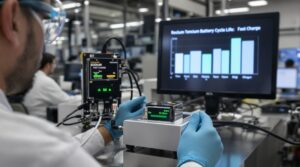New room-temperature sodium battery prototype delivers fast charging and doubles cycle life over lithium-ion in early tests
Researchers report a room-temperature sodium battery prototype that charges quickly and lasts longer than lithium-ion. Early tests show double the cycle life versus comparable lithium-ion cells. The lab device maintained…
Major streaming platforms test live-sports bundles to curb subscriber churn
The churn challenge for streaming growth Streaming leaders face persistent churn as promotions end, seasons wrap, and viewers chase must-have shows. Quarterly reports highlight volatile subscriber numbers across premium platforms.…
Smart rings go mainstream as Big Tech readies launches to challenge Oura’s dominance
Smart rings are leaving niche status and entering mainstream awareness. Hardware improvements, better software, and credible brands are driving momentum. Investors, analysts, and consumers now watch the category with fresh…
Red Sea shipping reroutes drive surge in freight costs and test global supply chains
Attacks on vessels near the Red Sea have altered global shipping patterns. Carriers have diverted sailings away from the Suez Canal to safer waters. The detours reduce risk for crews…
Major social platforms roll out default labels for AI-generated images and videos
Major social platforms now display default labels for AI-generated images and videos. These labels appear automatically when systems detect trusted metadata or strong signals. The change targets synthetic media that…
Antitrust scrutiny intensifies as a major tech firm moves to acquire a leading AI startup
A blockbuster deal has drawn regulators’ attention across multiple continents. A leading technology platform plans to acquire a prominent artificial intelligence startup. The transaction would marry vast distribution with cutting-edge…
Researchers unveil a fast-charging EV battery that reaches 80 percent in five minutes using a new silicon-dominant anode design
Researchers have revealed a lithium-ion battery that charges to 80 percent in five minutes. The advance centers on a silicon-dominant anode design. Their approach addresses the traditional limits of graphite…
New universal flu vaccine candidate shows strong protection across strains in Phase 2 data
A new universal flu vaccine candidate has posted encouraging Phase 2 results across multiple influenza strains. Investigators reported strong protection signals that extended beyond closely matched seasonal strains. The data…
Breakthrough weight-loss pill shows diabetes remission potential in late-stage trial
A late-stage clinical trial reports that an experimental weight-loss pill may drive remission of type 2 diabetes. Investigators observed meaningful improvements in blood sugar control alongside significant weight reduction. The…
Lab-grown coffee heads for pilot store launches as fermentation startups scale up production
Lab-grown coffee is moving from labs to storefront pilots as fermentation startups scale production capacity. Companies are targeting small retail tests to validate flavor, pricing, and consumer acceptance. These pilots…








